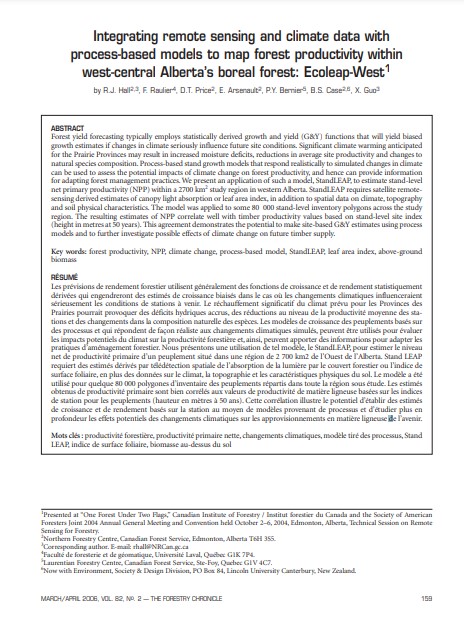Integrating remote sensing and climate data with process-based models to map forest productivity within west-central Alberta’s boreal forest: Ecoleap-West
Bosque Modelo:
Foothills
Temática:
Desarrollo humano
Tipo de documento:
Artículo científico
Resumen
Forest yield forecasting typically employs statistically derived growth and yield (G&Y) functions that will yield biased growth estimates if changes in climate seriously influence future site conditions. Significant climate warming anticipated for the Prairie Provinces may result in increased moisture deficits, reductions in average site productivity and changes to natural species composition. Process-based stand growth models that respond realistically to simulated changes in climate can be used to assess the potential impacts of climate change on forest productivity, and hence can provide information
for adapting forest management practices. We present an application of such a model, StandLEAP, to estimate stand-level net primary productivity (NPP) within a 2700 km2 study region in western Alberta. StandLEAP requires satellite remotesensing derived estimates of canopy light absorption or leaf area index, in addition to spatial data on climate, topography and soil physical characteristics. The model was applied to some 80 000 stand-level inventory polygons across the study region. The resulting estimates of NPP correlate well with timber productivity values based on stand-level site index (height in metres at 50 years). This agreement demonstrates the potential to make site-based G&Y estimates using process models and to further investigate possible effects of climate change on future timber supply.
Información Bibliográfica
Autor:
Hall, RJ, F Raulier, DT Price, E Arsenault, PY Bernier, BS Case and X Guo.
Revista:
Forestry Chronicle
Año:
2006
N°:
2
País :
Canadá
Páginas:
159 - 76
Volumen:
82
Idioma:
Ingles
Palabras claves
forest productivity, NPP, climate change, process-based model, StandLEAP, leaf area index, above-ground biomass





